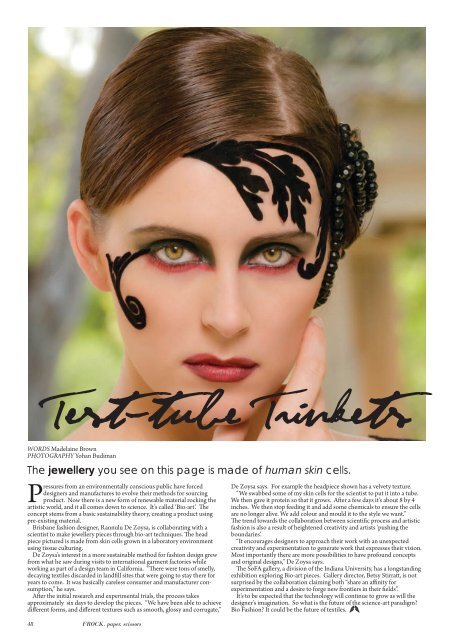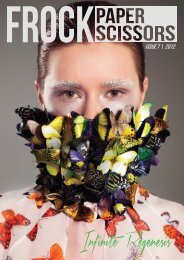The Beauty Curse - Frock Paper Scissors
The Beauty Curse - Frock Paper Scissors
The Beauty Curse - Frock Paper Scissors
Create successful ePaper yourself
Turn your PDF publications into a flip-book with our unique Google optimized e-Paper software.
Test-tube Trinkets<br />
WORDS Madelaine Brown<br />
PHOTOGRAPHY Yohan Budiman<br />
<strong>The</strong> jewellery you see on this page is made of human skin cells.<br />
Pressures from an environmentally conscious public have forced<br />
designers and manufactures to evolve their methods for sourcing<br />
product. Now there is a new form of renewable material rocking the<br />
artistic world, and it all comes down to science. It’s called ‘Bio-art’. <strong>The</strong><br />
concept stems from a basic sustainability theory, creating a product using<br />
pre-existing material.<br />
Brisbane fashion designer, Rannulu De Zoysa, is collaborating with a<br />
scientist to make jewellery pieces through bio-art techniques. <strong>The</strong> head<br />
piece pictured is made from skin cells grown in a laboratory environment<br />
using tissue culturing.<br />
De Zoysa’s interest in a more sustainable method for fashion design grew<br />
from what he saw during visits to international garment factories while<br />
working as part of a design team in California. “<strong>The</strong>re were tons of smelly,<br />
decaying textiles discarded in landfill sites that were going to stay there for<br />
years to come. It was basically careless consumer and manufacturer consumption,”<br />
he says.<br />
After the initial research and experimental trials, the process takes<br />
approximately six days to develop the pieces. “We have been able to achieve<br />
different forms, and different textures such as smooth, glossy and corrugate,”<br />
48 FROCK. paper. scissors<br />
De Zoysa says. For example the headpiece shown has a velvety texture.<br />
“We swabbed some of my skin cells for the scientist to put it into a tube.<br />
We then gave it protein so that it grows. After a few days it’s about 8 by 4<br />
inches. We then stop feeding it and add some chemicals to ensure the cells<br />
are no longer alive. We add colour and mould it to the style we want.”<br />
<strong>The</strong> trend towards the collaboration between scientific process and artistic<br />
fashion is also a result of heightened creativity and artists ‘pushing the<br />
boundaries’.<br />
“It encourages designers to approach their work with an unexpected<br />
creativity and experimentation to generate work that expresses their vision.<br />
Most importantly there are more possibilities to have profound concepts<br />
and original designs,” De Zoysa says.<br />
<strong>The</strong> SoFA gallery, a division of the Indiana University, has a longstanding<br />
exhibition exploring Bio-art pieces. Gallery director, Betsy Stirratt, is not<br />
surprised by the collaboration claiming both “share an affinity for<br />
experimentation and a desire to forge new frontiers in their fields”.<br />
It’s to be expected that the technology will continue to grow as will the<br />
designer’s imagination. So what is the future of the science-art paradigm?<br />
Bio Fashion? It could be the future of textiles.<br />
WX



